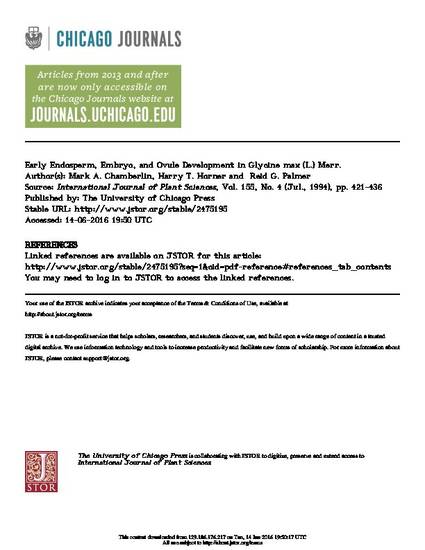
Article
Early Endosperm, Embryo, and Ovule Development in Glycine max (L.) Merr.
International Journal of Plant Sciences
Document Type
Article
Disciplines
Publication Version
Published Version
Publication Date
7-1-1994
Abstract
Anatomical and ultrastructural aspects of soybean embryo, endosperm, and ovule development are described for the zygote to late heart-shaped embryo stages (0-35 d postfertilization). Nucellar cells subtending the degenerative synergid break down, allowing for pollen tube passage to this synergid. In 15 of 17 ovules studied, the degenerative synergid occupies a position abfunicular to the zygote. The inner integument differentiates into the endothelium and exterior layers of thick-walled cells at the globular embryo stage. The endothelium has a cuticle on its inner surface that begins to fragment at the onset of endosperm cellularization. Cellularization of the free-nuclear endosperm is initiated at the globular embryo stage by the formation of anticlinal ingrowths of the central cell wall. These walls fuse to form cylinders open to the central cell. Uninucleate cells are formed within the bases of the cylinders as periclinal walls are laid down. These latter walls are formed in the presence or absence of phragmoplasts. At the onset of cellularization, the endosperm forms a cellular sheath over the apex of the embryo, which partitions it from the central cell. The late globular embryo forms a cuticle on its surface but not on the suspensor. The endosperm cells of the chalazal process are suspended in a mucilage because of the loss of the central cell wall in this region. Endosperm degeneration occurs by two different processes: one involves wall thinning coincident with accumulation of mucilage exterior to the plasmalemma and within the cytoplasm; the other involves the fusion of vesicles to the plasmalemma and the concomitant release of cell-wall fibrils. The embryo becomes reoriented 900 to accommodate its expansion within the embryo sac. The integrated development and function of these tissues toward embryo and ovule maturation are discussed.
Rights
Works produced by employees of the U.S. Government as part of their official duties are not copyrighted within the U.S. The content of this document is not copyrighted.
Language
en
File Format
application/pdf
Citation Information
Mark A. Chamberlin, Harry T. Horner and Reid G. Palmer. "Early Endosperm, Embryo, and Ovule Development in Glycine max (L.) Merr." International Journal of Plant Sciences Vol. 155 Iss. 4 (1994) p. 421 - 436 Available at: http://works.bepress.com/harry-horner/63/

This article is from International Journal of Plant Sciences 155 (1994): 421.